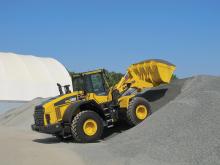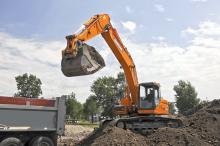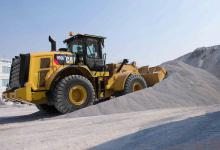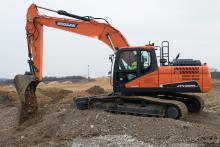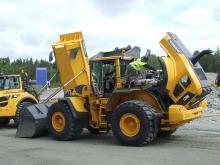Legislative and economic factors are impacting upon the earthmoving equipment market - Mike Woof reports
No-one who has any connection with the construction equipment sector can have failed to notice that increasingly tough emissions legislation has changed the shape of machines over the last 10 years or so. A series of targets have been set and met with regard to the exhaust emissions permitted from off-highway machines used in North America and Europe. The latest round of requirements has seen the intr
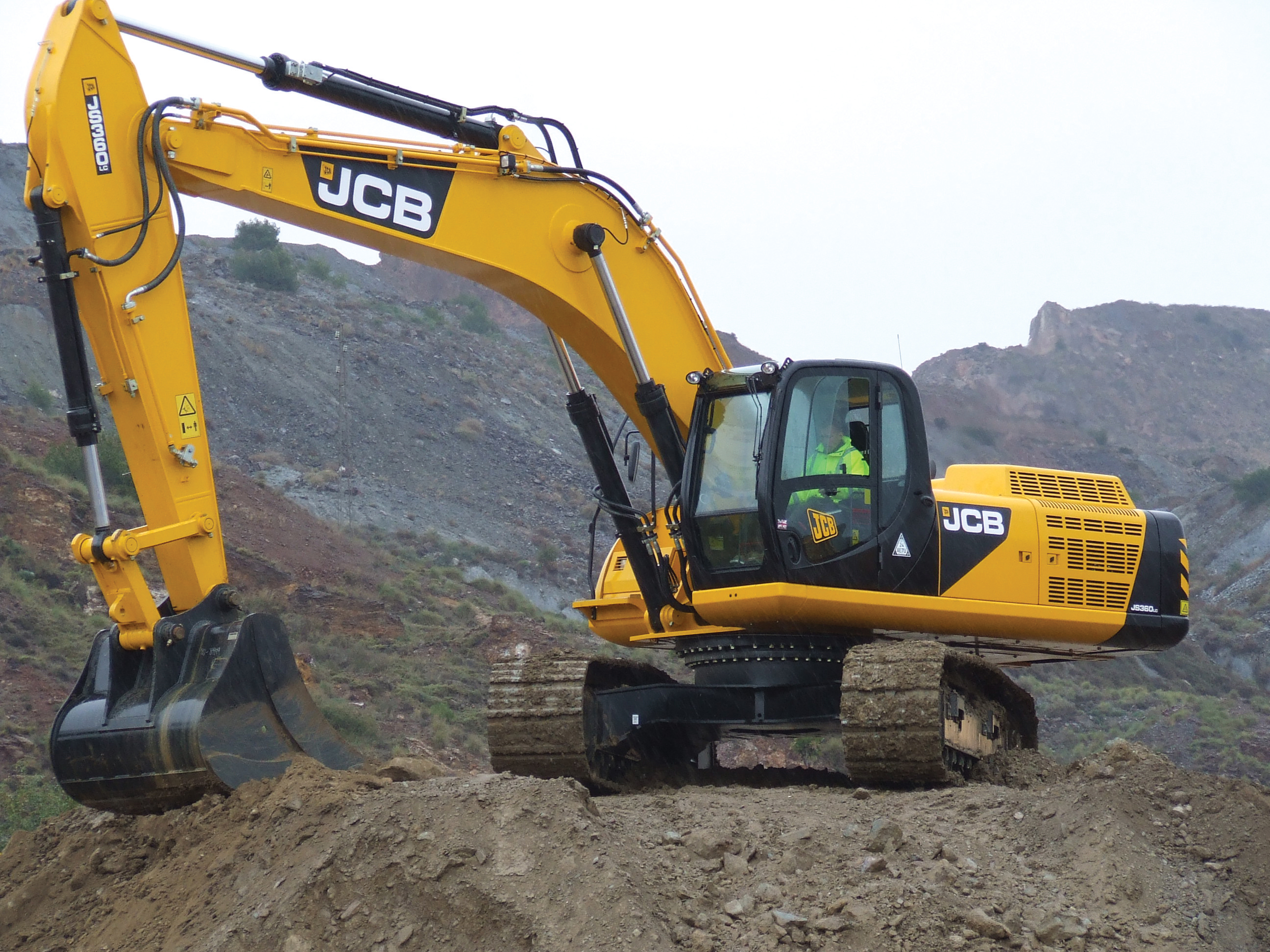
The new Caterpillar excavators offer performance improvements over previous models
Legislative and economic factors are impacting upon the earthmoving equipment market - Mike Woof reports
No-one who has any connection with the construction equipment sector can have failed to notice that increasingly tough emissions legislation has changed the shape of machines over the last 10 years or so. A series of targets have been set and met with regard to the exhaust emissions permitted from off-highway machines used in North America and Europe. The latest round of requirements has seen the introduction of the Tier 4 Interim/Stage IIIB legislation, with tough limitations on the quantities of NOx that each engine is allowed to release from the tailpipe.To meet this schedule, engine specialists have invested a great deal in technological solutions. All the engine firms are using similar technologies from an array available but in different ways and combined in varying packages. Key issues have included reducing fuel consumption and extending service intervals, partly in a bid to lower long-term running costs and address the increased purchase price of the machines due to the extra emissions control tools required. The size of the various emissions systems have also made external changes to the machines. These bulky units take up space, with manufacturers having to resort to careful design so as not to impinge upon sightlines from the cab and reduce operator visibility.
Similar issues affect all the new low emission engines, plus the machines they are used in. Firstly, these diesels run at higher operating temperatures and therefore require more cooling. At the same time, tougher working noise constraints mean that the cooling systems (and fans in particular) have had to be redesigned so as to ensure that the machines are quieter than before. The difference in operating noise is of note and standing alongside any of the new generation machines while the engine is running, it is apparent how much quieter these units are.
Because of the phased introduction of the emissions requirements, all of the manufacturers will be rolling out new crawler excavator and wheeled loader models during 2012.
This last is of note as a key development in the global construction equipment market at present is the emergence of Chinese manufacturers. Firms in Europe, Japan, Korea and the US are now seeing increased competition around the world from these Chinese manufacturers, particularly from the leading companies such as LiuGong, Sany, Shantui, XCMG, XGMA and Zoomlion. While Chinese firms have been exhibiting at international shows such as Intermat in Paris for some years now, the profile of these companies is increasing. From offering fairly limited selections from their respective ranges of models that meet European or North American legislative requirements, much broader compliant product line-ups are now available.
Chinese firms have exhibited an array of equipment such as bulldozers, concrete pumps, cranes, soil compactors and wheeled loaders at previous European shows. A few of those machines, wheeled loaders in particular, have found European customers. But the trickle is set to become a flood. In the European earthmoving equipment segment, crawler excavators represent a major portion of total machines sales. And a highly significant development at the Intermat event is the introduction of LiuGong’s 922E III machine. This Tier 4 Interim/Stage IIIB compliant 22tonner is pitched straight at the biggest volume segment for crawler excavators. It seems likely that established manufacturers (and their dealers) will pay particularly close attention to this excavator.
Chinese firms do not yet have extensive dealer coverage across Europe or North America but that will change. Recent acquisitions of European manufacturers by Chinese firms bring with them a good deal of knowledge of how the western market works, as well as product expertise. These Chinese manufacturers will be keen to build market share in the developed west, so the earthmoving equipment sector is set to become a good deal more competitive in the near future.
Caterpillar’s revised 20-24tonne E Series crawler excavators use the
The proven C6.6 ACERT uses the Cat Electronic Control Module (ECM) in combination with the Cat Clean Emission Module (CEM) to meet the EU Stage IIIB emissions standards. The CEM incorporates a Diesel Oxidation Catalyst (DOC) and a Diesel Particulate Filter (DPF). A passive regeneration system automatically cleans the DPF throughout the working cycle of the machine disrupting operation.
Doosan’s DX300LC-3 and DX340LC-3 excavators get the Korean maker’s DL08K common rail six-cylinder turbocharged diesel engine. This engine meets stage IIIB emission regulations due to EGR and DPF technologies. At 159kW, the DL08K engine in the DX300LC-3 excavator delivers 2% more power at a lower engine speed of 1,800rpm when compared to the existing stage IIIA version. The 210kW engine in the DX340LC-3 offers a 7% increase in power, also at lower engine revs and Doosan said factory tests show a 5-10% reduction in fuel consumption. In addition, a new ECO gauge on the control panel monitors fuel rate and actual engine load.
The new
Hyundai Heavy Industries Europe (HHIE) is releasing the first models of a new range of -9A Series excavators. The company says the existing -9 Series excavators are firmly establised in all major markets and has begun an update programme which will see the introduction of a new –9A Series. The most significant change is the introduction of EU Stage IIIB-compliant diesel engines, with reduced exhaust emissions and improved fuel economy, as well as other operating and control system refinements.
JCB says that its new generation JS crawler excavators deliver increased performance along with reduced running costs. The JS220, JS260 and JS360 are all powered by Isuzu diesels that meet the Tier 4 Interim/Stage IIIB emissions requirements with reduced fuel consumption and increased torque rise. The new JS220 provides an improvement in fuel economy of some 11% over the earlier model for example, with similar gains seen in the other new machines. The hydraulics are reconfigured and the pump layouts modified to increase speed and precision, while the valve blocks have also been repositioned to boost efficiency while digging. Heavy duty construction is said to offer increased working life. additional protection is available for machines in tough applications such as demolition, while a safety feature is the optional rear view camera.
Komatsu says its Dash 10 excavators bring improved efficiency, lower fuel consumption, better operator comfort and lower operating costs. Komatsu’s new Dash 10 models include the 26tonne PC240LC-10 and 31.9tonne PC290LC-10. The 26tonner gets a Stage IIIB/ Tier 4 Interim compliant 132kW Komatsu SAA6D107E-2 engine with a hydraulically actuated variable geometry turbocharger, EGR valve and diesel particulate filter. Users can expect 5% more power and up to 10% less fuel consumption, while an auto-deceleration system can reduce fuel use by up to 30%. A new cab gains strength from a reinforced tubular skeleton framework, while viscous damper mounts keep vibration levels under control. The larger PC290LC-10 gets more power, 159kW, but shares the PC240LC-10’s engine and emissions compliant technology.
Liebherr is introducing two new tracked excavators weighing 31 and 44tonnes. The 31tonne R936 replaces the R934C and brings with it a Stage IIIB/Tier 4i emissions compliant engine that delivers 160kW from a fourcylinder Liebherr engine. The new engine uses external exhaust gas recirculation and DPF with active regeneration to contribute to higher productivity and up to 15% higher fuel efficiency. At 44tonnes, the heavier R950 SME slots into the range between the R946 and R956 models. Power comes from a 10.5litre, sixcylinder common rail diesel engine producing 220kW. This benefits from external exhaust gas recirculation and DPF with active regeneration to meet Stage IIIB/Tier 4 Interim emissions regulations and offers up to 15% higher fuel efficiency.
LiuGong Machinery is unveiling its next generation excavators and is targeting the volume market with its 22tonne 922E III. The new E Series excavators are said to represent a major improvement for the firm, meeting world-class standards of quality and design. LiuGong said it is a range that will bring new gains in productivity quality, efficiency and serviceability. New Holland is introducing new heavyduty crawler excavators. The E385C and E485C are in the 35tonne and 48tonne category respectively.
New Holland said that the machines can cope with demanding applications and harsh conditions. The latest models offer more power and fast cycles with new Tier 4 interim engines and new hydraulics. Fuel consumption is improved through the new hydraulics and new ECO working mode. The E385C and E485C crawler excavators feature 213kW and 271kW engines respectively and meet the strict Tier 4 interim emissions standards with Cooled Exhaust Gas Recirculation (CEGR) technology. The CEGR system is fully integrated into the design of the two new models. The Hydrotonic system integrates electronic technology with the hydraulics and maximises performance according to the job being carried out. The upgraded New Holland Advanced Electronic earthmoving Processor introduces a new ECO working mode for optimised fuel consumption. The control monitor puts the operator in control of the efficiency of the machine’s performance, with the fuel economy meter showing the hourly consumption and the ECO Icon indicating when the machine is operating efficiently.
In the wheeled loader market meanwhile, Case Construction Equipment has expanded its F Series wheeled loader range with the introduction of the 521F and 621F. These use a central cooling pack design and rearmounted engine layouts. The machines have bucket capacities of 3.2tonnes and 4.3tonnes respectively and both feature an automatic front differential lock to ensure maximum tractive effort and high bucket fill factors when digging and loading. As with all F Series Case wheeled loaders, the 521F and 621F use Stage IIIB emissions compliant engines, adopting proven selective catalytic reduction (SCR) technology to provide increased output with reduced fuel consumption.
With a bucket capacity of 2m3, the DL200-3 is another in the Doosan line that benefits from a Stage IIIB emissions compliant engine. And with it, Doosan has taken the opportunity to freshen up the 12.2tonne loader. In addition to the 118kW DL06 engine, the loader gets a new cab offering better visibility, a revised hydraulic system with load sensing, and ZF axles with limited slip differentials. A hydraulic locking differential is available.
Hyundai Heavy Industries Europe (HHIE) is releasing the first models of a new range of -9A Series wheel loaders. The most significant change in this programme is the introduction of EU Stage IIIB-compliant diesel engines, with reduced exhaust emissions and improved fuel economy, and other operating and control system refinements.
JCB is moving up a class in the wheeled loader market with the introduction of its new 457 model. Replacing the earlier 456, the new 457 is the biggest and most powerful wheeled loader the firm has ever built and has a 235kg increase in load capacity. The new 8.9litre
New Holland is expanding its wheeled loader C Series with two new models at the top of the range. The W270C and W300C feature New Holland’s Tier 4 interim
The SL50W-3 wheel loader by Shantui has been fitted with planetary power shift transmission and a coxial flow amplification type hydraulic steering system for flexible operation and energy efficiency. Also kitted out with a Dongfeng Cummins engine, the SL50W-3 is said to have a highly articulated frame for a better turning radius and greater work flexibility. Its automatic bucketleveling function is said by Santui to ease operator handling, and its advanced Z-type reverse tipping mechanism with large breakout force ensures greater efficiency. The latest Volvo wheeled loaders to get the G-series revisions include the middleweight 11-17 tonne L60, L70 and L90 versions. The upgrade brings an electrically operated sloping bonnet, improving rearward visibility. All benefit from a revised cab layout, cleaner engines and improved hydraulic systems to deliver more productivity and greater efficiency. Power ratings are from 121-130kW, with all three sharing a Stage IIIB six-cylinder Volvo D6H motor that gets cooled EGR and DPF emissions equipment.
Volvo says that matching the engine, drivetrain and loadsensing hydraulic system has brought greater efficiency and faster cycle times. All three retain Volvo’s torque-parallel linkage, with the L90G for example, getting a 23% increase in lifting force and 19% more breakout. Fully automated powershift transmissions offer a choice of four gear-shifting programmes and a fuel saving accelerator system.

